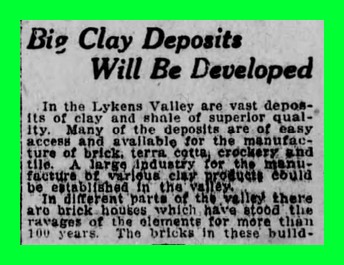The Midland Pennsylvania Railroad, begun in 1910, with plans to connect Millersburg, Dauphin County, Pennsylvania, with Ashland, Schuylkill County, Pennsylvania, turned out to be a colossal failure. In addition to the two terminal points of the railroad, stations were planned in Killinger, Berrysburg, Gratz, Springville, Valley View, Weishample and Mable. Great plans were formulated for the growth of commerce and farming. Much of the hype was presented in a Harrisburg Telegraph article in 1911. That article is transcribed here in several parts, with part seven and final part presented today.
This part tells of the prospects for expansion of coal mining in the valley and surrounding areas that will supposedly come about with the construction of the railroad.
From the article that appeared in the Harrisburg Telegraph, 16 March 1911:
Big Clay Deposits Will Be Developed
by Robert F. Gorman
In the Lykens Valley are vast deposits of clay and shale of superior quality, Many of these deposits are of easy access and available for the manufacture of brick, terra cotta, crockery, and tile. A large industry for the manufacture of various clay products could be established in the valley,
In different parts of the valley there are brick houses which have stood the ravages of the elements for more than 100 years. The bricks in these buildings were all mad by hand and “burnt” in the old fashioned way from clay found in the valley. Modern methods have never been applied to the clay in any part of the valley. With the proper machinery, bricks could be manufactured that would compare with any made in any part of the United States, experts assert. Analysis shows that the Lykens Valley clays are rich in silica and alumina.
Years ago crocks were manufactured by hand in different parts of the valley, but the lack of proper railroad facilities and the establishing of modern machinery for the manufacture of crockery in other parts of the country caused the “hand made crock” industry to go out of business.
With the building of railroads the clay development will become extensive and some large factories for the manufacture of crockery, etc., will be established.
For all other parts of this series, click here.
_________________________________
News article is from Newspapers.com.
Corrections and additional information should be added as comments to this post.
